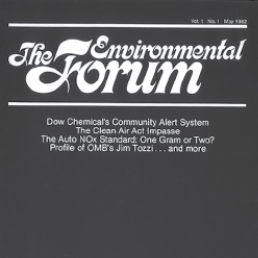In this issue, we celebrate the 40 complete volumes of the Environmental Forum. Few magazines make it to their fifth decade, which we begin with this issue. It’s an odd anniversary, because the magazine was founded 42 years ago, but there was a period when the publication was discontinued and then arose Phoenix-like two years later into the incarnation you are holding in your hands today.
“People are policy.” Those words figured prominently in the founding of the Environmental Law Institute’s policy journal in 1982. My re-immersion into the content of those 48 original monthly issues in preparation for this article proved to be not only fun, but also encouraging and enlightening. Our small editorial staff—me and editorial assistant Jan O’Brien—had a good time, with lots of fun, on that job. We were serious about the task, while not taking ourselves too seriously. There is at least anecdotal evidence that our readers had fun with the publication too.
I recall having been asked in the early 1980s by an out-of-town corporate environmental official to name which Republican staffers of a relatively obscure House subcommittee might be most receptive to hearing his pitch. Better he might ask his company’s own D.C. policy staff, I thought at the time, or at least the environment staffer of whichever trade association represented his industry.
What I didn’t realize was that the Forum had a reputation, and top people in the various sectors composing the environmental community came to us willingly. For the big dogs in the Washington environmental policy community—EPA administrators, deputy and assistant administrators, chairs and key minority members and staff of congressional committees and subcommittees, top industry and NGO lobbyists, policy gurus, and journalists covering the beat—we used our regular Profile department. For an upstart, we managed to hook some pretty big fish.
We also capitalized on a growing inside-the-Beltway reputation that we “knew everybody.” True or not, or simply exaggerated, we did nothing to dispel that view. For those environmental movers and shakers not quite up to the Profile standing, we regularly carried a People to Know feature—a headshot and brief bio along with, when possible, a wrap-up along the lines of, “Serve to her backhand.” This department cemented the impression of our casual relationships with the leaders in the profession.
There was more of this people emphasis: Most monthly issues concluded with a Who’s Who…and Where? listing: Joe Blow or Susie Somebody had left their post as special assistant at XYZ and now was holding forth at ABC. We made no pretense of actually knowing all those included in this quick-hit feature, but it helped secure the impression among our readers that we had a far-reaching network. The Forum continues this tradition today, with the current iteration labeled Movers & Shakers—see page 61.
There were other standing departments too. A popular conversation item at many a D.C. environmental dinner party or other get-together was our Horse Race feature (see the previous page). Fancy it was not, but rather a hand-drawn image of thoroughbreds representing half-a-dozen major pollution control bills and their prospects, or lack of same, for final enactment in that year’s legislative calendar. (Interesting to think back to a time when multiple environmental bills were getting Capitol Hill’s attention, a big change from nowadays.) Drawn up only in the final moments before each issue’s go-to-press deadline, this feature took on a life of its own, including my often being introduced as “the guy who does the horse race.”
We did not take ourselves too seriously with these sometimes tenth-of-a-percentage-point increases or decreases month-to-month: We carried upside-down italicized wording at the bottom of these features, as follows:
You did it! Anyone who turns the page upside down to read this is MUCH too serious about this feature. Don't do it again!
Another fun standing department was a Memo of the Month, usually near the end of each issue. These had to stand on their own: If they required elaboration or explanation, they didn’t make the cut. A somewhat sobering lesson from some of these cited features is that the less intellectual time committed to a particular article, the better it did in attracting eyeballs, as reporters would say today. It’s a humbling lesson many a journalist and editor must balance in their own endeavors, when pressed to increase traffic to their site.
Which is not to dismiss the value and importance to the magazine of its more substantive articles. We presented a feature labeled Point-Counterpoint, addressing a wide range of timely and often controversial environmental issues. We included face-to-face roundtable discussions with top-notch and diverse participants expressing widely opposing perspectives on a broad range of issues. The Forum provided in-depth analyses of regulatory developments, and of especially important court decisions. Finally, we provided commentaries on various interests’ communications and lobbying messages. In my recent review of those first four years, I’m struck that our tiny upstart magazine managed to corral such big names to participate in these roundtables and other features.
But I am getting ahead of myself, ignoring how the Forum came to be in the first place—and how fortunate it was to have been undertaken by ELI, with the full hands-off institutional support of then President J. William (Bill) Futrell, a one-time Sierra Club president and civil rights attorney whose support for the Forum, starting from day one, was to prove critical.
The fact is that prior to launching the magazine as fulltime-ELI employees in early 1982, Jan and I had been among some three-dozen environmental professionals who were thrown out onto the Washington streets suffering under then EPA Administrator Anne M. Gorsuch’s “doing more with less” theme. Yes, that meant fewer and far less experienced and professional staffing. We all had been staff on the congressionally chartered Clean Air Act National Commission on Air Quality, assuming we would be hot prospects for many environmental posts. Not so in President Reagan’s early first-term in the Nation’s Capital.
I personally had cut my environmental reporting teeth as the top editor on the weekly environmental “information service” Environment Reporter, published by the Bureau of National Affairs, back then an employee-owned specialized service eventually subsumed as part of the Bloomberg news empire. We at BNA, perhaps not surprisingly but not entirely with keen-eyed impartiality, at that time somewhat looked down on our erstwhile news and analysis competitors, including those at ELI.
After working more than two years as an assistant director with NCAQ, followed by a few months of freelance writing and college lecturing and teaching, I met with Futrell so I could describe my goal of returning to journalism with an environmental policy, politics, law, and people periodical. To my undying delight, Futrell decided to give it a try.
So we launched the magazine. It was the early years of the personal computer revolution. Then as now, the Forum was in the vanguard. We used my home IBM PC in the absence of any ELI computers, and we relied on MS-DOS, the arcane operating system, and two floppy disk drives. Jan regularly worked from my home office. She entered copy electronically and learned to code it for direct feed into typesetting equipment.
Remember, this was not the robust era of environmental full-employment opportunities. Rather, the most attention-getting issue, Superfund hazardous waste cleanups, was on the downturn, and climate change wasn’t even a glimmer in the eye of environmental policymakers or of most in the advocacy community. Job vacancies went unfilled, environmental careers were going bust.
Not then, or perhaps ever since, was ELI a money bag of excess revenues and vast career potential. But Futrell had the vision, and the internal administrative chutzpah, to launch this venture in the face of what clearly were apprehensions among some staff and also some of the institute’s more revenue-conscious board members. As ELI president at that point for only about two years, Futrell was eager to better service the institute’s would-be members by going beyond the purely lawyerly emphasis of the Environmental Law Reporter. His hands-off approach, leaving the editorial side of the journal in my hands, struck me as ideal.
Which, I emphasize, did not consist of wholly original ideas. I think our monthly News Notes and News Break features were inspired by the first-page, column-eight “News You Can Use” feature of the Wall Street Journal. Our informal, conversational style was inspired at least in part by the two-year-old revolutionary news delivery tone and culture being pioneered at that time by National Public Radio’s All Things Considered. Our people and personalities features no doubt sought to mimic—for better or worse—the tone and tenor of a People magazine, perhaps something akin, shudder the thought, to today’s Entertainment Tonight.
No threat to large-circulation periodicals, nor for that matter even to the few specialized environmental, natural resources, and pollution control publications tilling those fields in the early 1980s, the Forum from the start had never sought to make or break news. That just wasn’t our gig, but rather the domain of the likes of Inside EPA and Air/Water Pollution Report, a publication of Business Publishers, Inc.
Rather, the Forum’s shtick was to help readers make sense of the abundant and complex environmental breaking news that others provided. Our thing was to cover the Why, and not the What, of environmental news: Why did it happen as it did? Who were these faceless bureaucrats, lobbyists, policy wonks, “liaisers” and facilitators and conveners whose faces, let alone their names, were generally unknown?
So the Forum from day one sought not to be the first to tell its audience that such and such had happened. And we didn’t seek to tell them what they should think, but rather what they should think about. Then, as now, the magazine sought not to report the news, but rather to help others better understand what it all meant, how it came to be, and what it meant to them going forward.
These four decades (and various journalism jobs) later, I still think fondly of, and with unending gratefulness for, those years at the birthing of the Forum. I still tingle, several years after the magazine temporarily went dark after a Superfund financing controversy stalled overhead funding for ELI, at the memory of crossing where K Street and Connecticut Avenue intersect. Midway, I was suddenly approached by a pedestrian who reached out to me and said, “Didn’t you used to be Bud Ward, who did the Horse Race feature?” Made my day, and I relish that memory all these years later.
ELI, it ends up, was the best—and very probably the only—organization culturally suited to sponsoring the Forum as I had been envisioning it. We collectively recognized the need for nonpartisanship in pursuit of environmental protection. That suited not only Futrell’s but also all of ELI’s goal of being inclusive and diverse in its appeals to pragmatic activists as well as to practical conservatives.
My heart-felt appreciation and thanks to Bill Futrell, and to the dedicated and highly skilled professional staff and volunteer leaders and so many authors, and for the true joys and satisfactions of having allowed Jan and me to shepherd the Environmental Forum in its formative years—and, we want to believe, helping to lay a strong foundation for all the magazine has gone on to accomplish.
Bud Ward was editor of the Forum from 1982-86. Carole Parker was editor from 1988-90. Stephen R. Dujack has been editor since 1990.





